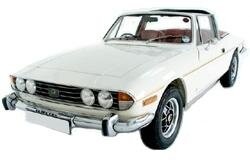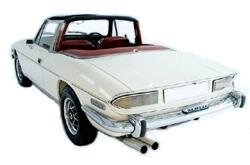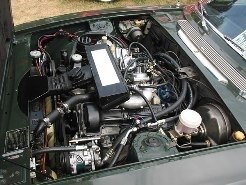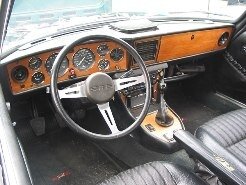Model Page
Triumph Stag

|
Produced: |
1970 - 1977 |
|---|---|
|
Production Run: |
25,939 |
|
Built: |
Canley (UK) |
|
Engine: |
Triumph 2,997cc V8 |
|
0-60: |
9.7 secs |
|
Max Speed: |
120 mph |

The story of the Triumph Stag is one of “what could have been”. The Stag is a four seater convertible coupe powered by a Triumph V8 engine. The Triumph Stag was styled by Giovanni Michelotti, a man responsible for design of the Herald, Spitfire, GT6, TR4, 2000, 1300 and Dolomite.

Triumph Stag
The Triumph Stag started life as a styling experiment, Michelotti had been loaned a Triumph 2000 by the then Director of Engineering at Triumph Harry Webster. Michelotti wanted a vehicle to use as a basis for a show car so that he could display his talents at an upcoming motor in Turin. Webster made an agreement with Michelotti that he could have the use of the Triumph 2000 on the condition that he could have first refusal on the car and use the proto-type as a basis for a new Triumph. Webster fell in love with the proto-type and the car was promptly shipped back to Triumph with the design being subsequently purchased – the car was never shown at the show.
Sir Donald Stokes, the Managing Director of British Leyland was convinced by Harry Webster that the car would be a sales success within the profitable Grand-Tourer market both at home and in America. Marketing surveys projected 12,000 sales per year, this was more than enough demand to put the car into production.
The Triumph Stag project was given the official green light in 1966, responsibility for the development of the car was trusted to Spen King and a launch date was pencilled in for 1968. The launch date became less and less likely as development continued, the Stag design brought up a number of problems – the first being the strength and rigidity of the monocoque shell. Being a convertible the strength of the basic shell was weekend, the problem was solved using what is commonly referred to as the T bar. The T bar is a rollover bar that braced both B pillars, this brace also being braced to the centre of the windscreen. As a by-product, this arrangement neatly solved the problem of complying with American rollover standards.

Rear shot of Triumph Stag
Two engines were proposed for the Stag, the first was a larger version of the 2.1 straight six from the TR range, or the use of the new 2.5 V8 coupled with fuel injection that was in Development at Triumph. Webster wanted the Stag to utilise the new Triumph V8, the engine had to be increased to a 3.0 litre capacity the primary reason being to overcome the weak torque characterirstics inherent in the 2500cc motor. The troublesome fuel injection system was shelved with the engine being fed using dual Zenith-Stromberg 175 CDSE carburettors. This configuration allowed for the car to meet emissions targets for the valuable US market.
Perhaps if the Rover V8 had been used at this time the Stag would have enjoyed much greater sales success however this was not possible at the time as Rover were unable to supply sufficient quantity of engines.
As the car had been based on a triumph 2000 originally designed for a straight six, considerable engineering work had to be applied to the engine bay to get the V8 to fit. The gearbox was reworked to cope with the extra power and torque produced by the v8, larger brakes and 14 inch wheels were fitted to the car. Electric windows were fitted as standard.
The chassis was shortened by six inches and an all coil independent suspension with the proven front MacPherson struts were fitted, power assisted steering was fitted as standard. The conventional rear wheel drive setup was employed.
Development of the car crawled along and pre-production models were not available until late 1969, overshooting the target production date – the car being finally launched in June 1970. The car was generally well received at first but the goodwill did not last too long. Soon after the first shipment problems arose due in part to poor design and poor build quality standards – a sorry state of affairs when the car was competing directly with the Mercedes Benz SL.

Triumph Stag Engine Bay
Common problems reported included timing chains braking after only 25,000 miles service – a problem due to long simplex roller link chains coupled with poor engine maintenance related to the factory specified 7,500 mile oil change intervals. With these chain fails, an expensive repair bill often followed.
The aluminium head often warped due to poor castings, the head-gaskets restricted cooling that subsequently led to overheating. Water pumps failed on a frequent basis, this was mainly cuased due to poor drive gear hardening prematurely wearing out the drive gears. Overheating problems were exaggerated due to clogged waterways in the cylinder block – it was discovered that the waterways were filled with sand left form the casting during manufacture!
All these problems have been solved by the enthusiast mechanic over the years, and no doubt had Triumph engineers being given the time and the money to correct these flaws they too would have resolved the issues. Who knows how many cars the Triumph V8 would have powered had the fundamental flaws been properly addressed.
During the seven year production period, two Mk’s of the car were produced. The Mk1 was produced between 1970 and 1973, with the final Mark 2 being available from 1973 to the Stag’s demise in 1977.
The Mk1 can be readily identified by the lack of chrome sill covers, exclusion of side stripes and lack of head rests on the front seats. More subtle differences are that the interior lights are attached to the B post. The wheels were standard steel adorned with rostyle hub cabs. The number plate lamps were place on the bumper rather than the boot lid and the dashboard instrumentation differs slightly.

Triumph Stag Interior
The Mk2 included a single window soft top, side stripes and alloy wheels as standard. The front seats came complete with headrests and chrome strips were now fitted along with chrome sill covers. The number plate lamps had migrated to the boot lid and the interior light now housed on the T bar.
Most cars leaving the factory were fitted with the Borg-Warner 3 speed automatic gearbox, the other option available to owners was a gearbox taken from the TR2. This gearbox had been improved over the years for use in the later TR models. This gearbox could be ordered with optional overdrive unit making the driving experience much more pleasant due to the reduced revs at cruising speed. Other optional extras from the factory including air conditioning, luggage rack, koni shock absorbers, Lucas Square Eight fog lamps and chrome wire wheels.
The Triumph Stag has become a popular classic car today and around 9,000 cars are believed to exist in the UK – an ironic testament to the build quality of these sought after cars.
The Facts
|
Engine: |
Triumph V8 @ 90 Degrees |
|---|---|
|
Capacity: |
2,997 cc |
|
Valves: |
16 |
|
Compression Ratio: |
9:1 |
|
Fuel System: |
Twin Side-draught Stromberg 175 -CDS |
|
Maximum Power: |
146bhp @ 5,700 rpm |
|
Maximum Torque: |
167lb ft @ 3,500 rpm |
|
Transmission: |
Manual 4 Speed / 3 Speed Automatic |
|
Top Gear: |
22.6 mph per 1000 rpm |
|
Brakes: |
Servo Assisted Vented front discs / rear drums |
|
Kerb Weight: |
1355 Kg |
|
0-60: |
9.7 secs |
|
Max Speed: |
120 mph |






